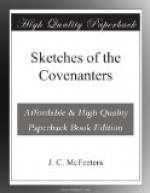Welch was dissatisfied with the Declaration. It was too forceful for him. He would tone it down, that it might soothe the king, placate the Duke of Monmouth, condone the Indulged ministers, and restore Weir to the ranks. He presented a new Declaration as a substitute for the one already in force. For two weeks, even till the enemy was lining up for battle, he agitated the question. The majority was always against him. At last Hamilton, the commander, contrary to his convictions, yielded for the sake of peace. He hoped by this means to save his distracted army, that with solid ranks he might meet the foe and win the fight. But he sadly mistook policy for wisdom. The battle of Bothwell Bridge was lost that moment. The battle was lost before a shot was fired. Hamilton surrendered before he met Monmouth. He had displaced the truth for the sake of harmony. His flag is already furled, there will be no fighting now except by the heroes of the van-guard. The Divine favor that gives victories has been withdrawn. The martial spirit has fled from the leader and his men are weak as women.
On Sabbath morning, June 22, 1679, the king’s army, 15,000 strong, was massed on the north bank of the Clyde; on the south side, the Covenanters numbering 5,000 confronted them. The narrow bridge lay between them. Hackston, Paton, and Balfour, with 300 Covenanters stood at its south end. The rest of the army was behind them on the moor with gunshot, standing in eleven solid squares; six banners waved proudly over them. They had one cannon, two detachments of cavalry, and a body of skirmishers.
Monmouth orders his troops across the bridge. A solid column pushes forward broad as the bridge is wide; step follows step in that dread procession, when lo, a spreading puff of smoke rises on the bank in front, and a cannon ball is hurled among them, while muskets pour forth volleys of death. The bridge is strewn with bleeding men and the broken ranks fall back. The Duke orders another charge. A second column moves hurriedly over the gory path of their fallen comrades to meet the same fate. Again and again, the attack and the repulse. They attempt to ford the river, but Balfour with his sharpshooters hurls them back, while many a brave man lies down in the cool stream to rise no more. The bridge drips with blood; the Clyde is crimsoned. After three hours the Covenanters’ ammunition fails, and Monmouth rushes the bridge. The Covenanters meet them with swords, but are overpowered; they fall back upon the main body and find it unfit for action.
[Illustration: The battle of Bothwell bridge.
The Battle of Bothwell Bridge was fought on Sabbath, June 22, 1679 The king’s forces numbering 15,000, under the Duke of Monmouth, assailed 5,000 Covenanters under Robert Hamilton. For three hours Captain Hackston, with 300 Covenanters, held the bridge. At length their ammunition was exhausted, and the royal army forced their way across. The Covenanters took flight and were savagely slaughtered in the stampede 400 were slain, 1,200 captured, and the rest scattered. A granite monument has been erected at the bridge in honor of the Covenanters.]




